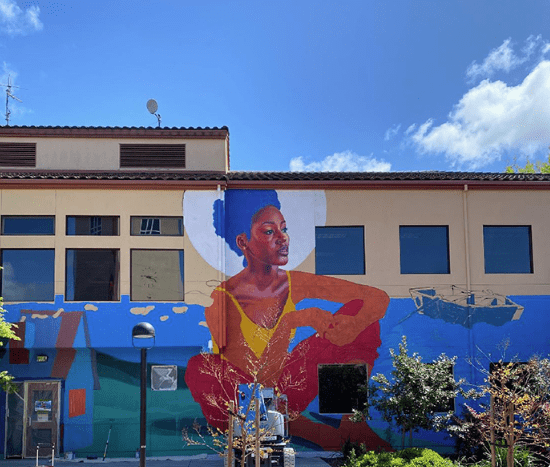
Santa Rosa Junior College (SRJC) Petaluma’s Intercultural Center, Our House, has unveiled a custom work of art and culture. The 30’ x 80’ mural on John M. Jacobs Hall surrounds the Our House entrance and leads into the center for student life and community-building.
The mural was created to produce learning environment aesthetics in harmony with Petaluma campus values and is meant to externally mirror the transformations occurring within the facility and the students.
“We strive to reflect the cultures and backgrounds of the wide variety of students we serve; to be culturally representative and responsive to our community,” said Michelle Vidaurri, Director of Student Engagement & Support Services. “The Our House mural imagery represents our ethnic diversity and incorporates the symbolism of the journeys our students and their families have undertaken to become members and influencers in our college community.”
The project was a collaboration with staff, students, and Sonoma County muralists, Joshua and MJ Lindo-Lawyer. The artists heard each person’s story and what SRJC and Our House meant to them. After creating designs incorporating those ideas, the Our House team voted on which ones best fit their vision. From there, the muralists developed a final design for approval and began painting during the second week of April. The mural was completed on May 2.
“The Our House team was great and we felt very in tune with the stories told,” said Lindo-Lawyer. “They helped our design process go smoothly and we are happy with the final outcome. Having gone to SRJC for art, there was a sense of accomplishment in adding a mural to the campus.”
Onboard from its conception, Elizabeth Cole was Vice President of Student Life for the Petaluma campus when Vidaurri asked her to be the student voice for the mural’s creation. She is now the Student Trustee representing all SRJC students on the Sonoma County Junior College District Board of Trustees.
“I am honored to have been able to be a part of it, to have been chosen out of all of the students,” said Cole. “It was important that it represents collective consciousness, be inclusive, and be art that resembles people so they feel represented. At Our House, you are respected for who you are and it is there to help you.”



